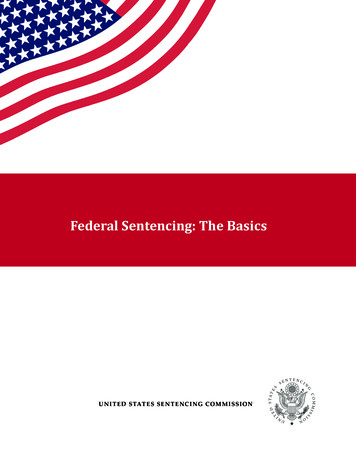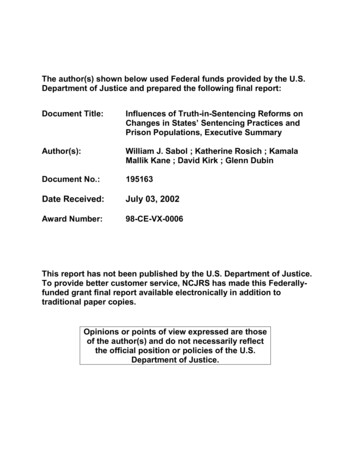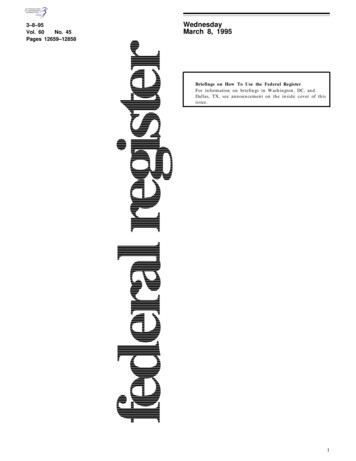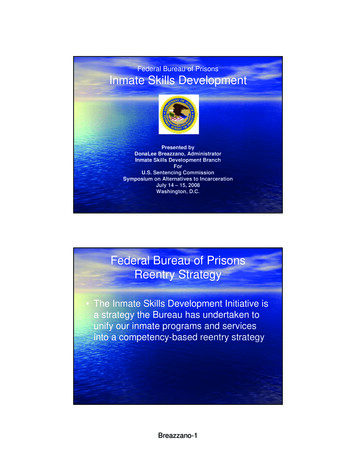
Transcription
Federal Sentencing: The BasicsU N I T E D STAT E S SE N T E NC I NG COM M I SSION
United States Sentencing CommissionOne Columbus Circle, N.E. Suite 2-500Washington, DC 20002www.ussc.govDisclaimer: This document serves as an update to the August 2015 publication authored by theCommission’s staff. It is offered to assist in understanding and applying the sentencing guidelines,related federal statues, and rules of procedure. The information in this document does not necessarilyrepresent the official position of the Commission, and it should not be considered definitive orcomprehensive. The information in this document is not binding upon the Commission, courts, orparties in any case.November 2018
Federal Sentencing: The Basics – 2018Table of ContentsI.Introduction.1II.The Evolution of Federal Sentencing Since the 1980s.1III.Overview of the Federal Sentencing Process.5A. Guilty Pleas and Plea Bargains.5B. Presentence Interview.6C. Presentence Report and Objections.6D. Sentencing Hearing.7IV.The Nature of a Federal Sentence.8A. Types of Sentences Available By Statute.8B. The Booker Three-Step Process in Sentencing.11C. “Relevant Conduct” as the “Cornerstone” of the Guideline System.12V.Basic Guideline Application.13A. Application Instructions.13B. Applying the Guidelines.15C. Chapter Four “Overrides”.18D. Departures and Variances.18E. Fines.19F. Supervised Release Under the Guidelines.20VI.Appellate Review of Sentences.20VII.Violations of the Conditions of Probation and Supervised Release.21VIII.Guideline Amendment Process.22A. The Amendment Cycle.22B. Retroactivity of Amendments.23IX.A Brief Overview of Sentencing Data.24A. The Commission’s Collection and Analysis of Sentencing Data.24B. Snapshot of Federal Offenses and 42i
United States Sentencing Commissionii
Federal Sentencing: The Basics – 2018Federal Sentencing: The BasicsI. IntroductionThis paper provides an overview of the federal sentencing system. For historicalcontext, it first briefly discusses the evolution of federal sentencing during the past fourdecades, including the landmark passage of the Sentencing Reform Act of 1984 (SRA),1 inwhich Congress established a new federal sentencing system based primarily on sentencingguidelines, as well as key Supreme Court decisions concerning the guidelines. It thendescribes the nature of federal sentences today and the process by which such sentencesare imposed. The final parts of this paper address appellate review of sentences; therevocation of offenders’ terms of probation and supervised release; the process whereby theUnited States Sentencing Commission (the Commission) amends the guidelines; and theCommission’s collection and analysis of sentencing data.II. Evolution of Federal Sentencing Since The 1980sBefore the federal sentencing guidelines went into effect on November 1, 1987, federaljudges imposed “indeterminate” sentences with virtually unlimited discretion within broadstatutory ranges of punishment, and the United States Parole Commission would thereafterdecide when offenders were actually released from prison on parole.2 The Supreme Courthas recognized that “the broad discretion of sentencing courts and parole [officials] hadled to significant sentencing disparities among similarly situated offenders.”3 As foundby members of Congress who enacted the SRA: “[E]ach judge [was] left to apply his ownnotions of the purposes of sentencing. . . . As a result, every day federal judges mete[d] outan unjustifiably wide range of sentences to offenders with similar histories, convicted ofsimilar crimes, committed under similar circumstances.”4In response to both concern regarding sentencing disparities and also a desire topromote transparency and proportionality in sentencing, Congress created the UnitedStates Sentencing Commission, a bipartisan expert agency located in the judicial branch.5The Commission is composed of up to seven voting members, including a chair, who arenominated by the President and must be confirmed by the Senate. No more than fourCommissioners can be from the same political party, and at least three Commissionersmust be federal judges.61
United States Sentencing CommissionThe SRA directs the Commission to establish sentencing policies and practices intwo primary ways: (1) by promulgating (and regularly amending) the federal sentencingguidelines; and, (2) by issuing reports to Congress that recommend changes in federallegislation related to sentencing. The SRA also directs the Commission to establish adata collection and research program for the purpose of serving as “a clearinghouse andinformation center” concerning sentencing-related issues and to establish a training branchto provide education about federal sentencing practices to federal judges, prosecutors,defense counsel, and probation officers.7The Commission has a staff of approximately 100 attorneys, social scientists, and otherprofessionals with expertise in criminal justice and sentencing, led by the Commission’sStaff Director. The staff’s organization reflects the various statutory functions in the SRAand includes, among others, the Offices of General Counsel (OGC), Research and Data(ORD), Education and Sentencing Practice (OESP), and Legislative and Public Affairs(OLPA).The SRA and contemporaneous federal sentencing legislation created a fundamentallydifferent sentencing system from the prior system, with the guidelines being the centralfeature and with parole no longer available for offenders convicted of offenses committedon or after November 1, 1987.8 Congress specifically directed the Commission to createguidelines that increased existing penalties for “many” types of cases, such as “serious”white-collar offenses and violent offenses.9 Before the initial set of guidelines waspromulgated, Congress also enacted statutes creating mandatory minimum penalties forseveral commonly prosecuted drug-trafficking and firearms offenses10 and prohibitingprobation for certain offenders.112
Federal Sentencing: The Basics – 2018With respect to the sentencing process itself, the SRA (in 18 U.S.C. § 3553(a)) setsforth seven factors that a sentencing court must consider:Seven Factors to be Considered at Sentencing(1) the nature and circumstances of the offense and the history and characteristics of the defendant;(2) the need for the sentence imposed to reflect the four primary purposes of sentencing, i.e., retribution,deterrence, incapacitation, and rehabilitation;(3) the kinds of sentences available (e.g., whether probation is prohibited or a mandatory minimumterm of imprisonment is required by statute);(4) the sentencing range established through application of the sentencing guidelines and the types ofsentences available under the guidelines;(5) any relevant “policy statements” promulgated by the Commission;12(6) the need to avoid unwarranted sentencing disparities among defendants with similar records whohave been found guilty of similar conduct; and(7) the need to provide restitution to any victims of the offense.13Significantly, two of the seven factors in section 3553(a) are the guidelines and the policystatements promulgated by the Commission, and the remaining five reflect factors that theCommission itself considers in promulgating the guidelines and policy statements.14 Asthe Supreme Court has recognized, “the sentencing statutes envision both the sentencingjudge and the Commission as carrying out the same basic § 3553(a) objectives, the one, atretail, the other at wholesale.”15The SRA specifically directed the Commission to do three things in draftingguidelines that significantly narrowed the degree of sentencing discretion previouslypossessed by judges: (1) create a “detailed set of sentencing guidelines” that addresses “allimportant variations that commonly may be expected in criminal cases, and that reliablybreaks cases into their relevant components and assures consistent and fair results”;16(2) prohibit or limit consideration of several personal characteristics of defendantsregarding sentencing;17 and (3) significantly limit the breadth of the individual sentencingranges within the guidelines’ sentencing table such that “the maximum of the range . . .shall not exceed the minimum of the range by more than the greater of 25 percent or sixmonths” (commonly referred to as the “25 percent rule”).18 These limitations were createdfor the primary purpose of providing “certainty and fairness in meeting the purposes ofsentencing, [while] avoiding unwarranted disparities among defendants with similarrecords who have been found guilty of similar criminal conduct . . . .”19In the SRA as enacted, courts were required to sentence defendants within theapplicable guideline range unless either the Commission had created a permissible basis fora “departure” from the range or there existed “an aggravating or mitigating circumstance of akind, or to a degree, not adequately taken into consideration by the Sentencing Commission3
United States Sentencing Commissionin formulating the guidelines that should result in a sentence” outside of the applicablerange.20 Departures from the range were limited in order to reflect Congress’s desire forgeneral uniformity in sentencing of similarly situated offenders, without consideration ofseveral offender characteristics deemed irrelevant to the sentencing decision, including“socio-economic status.”21In 1987, the original Commission responded to Congress’s directives in the SRA withthe first Guidelines Manual containing a detailed set of guidelines and policy statementsthat included a sentencing table (discussed infra in Part V.B.5) with much narrowersentencing ranges than the larger statutory sentencing ranges governing federal crimes.22For instance, in a bank robbery case in which the indictment does not allege that thedefendant used a dangerous weapon, the statutory range of punishment is zero to 20 years,while a typical guideline range in such a case is much narrower (e.g., 78-97 months).23In 2005, in United States v. Booker,24 the Supreme Court declared that the existingguideline system violated the Constitution by permitting judges to find facts that raisedthe guideline range by a preponderance of the evidence (as opposed to juries making suchfindings beyond a reasonable doubt). The Court in Booker remedied the constitutionaldefect by striking the provisions of the SRA that made the guidelines “mandatory;” theresult was a judicially modified guideline system that the Court described as “effectivelyadvisory.”25 After Booker, courts use a three-step process—discussed below in Part IV.B.—in which they properly calculate and consider the guidelines as well as any relevantpolicy statements, along with the other five statutory factors in 18 U.S.C. § 3553(a) (setforth above), in deciding what sentence to impose within the broader statutory range ofpunishment.26The Court repeatedly has stressed that the advisory guidelines remain the “startingpoint and the initial benchmark” in the federal sentencing process and, moreover, “districtcourts must . . . remain cognizant of them throughout the sentencing process.”27 As theCourt has stated, “[t]hese requirements mean that in the usual sentencing . . . the judgewill . . . impose a sentence within [the applicable] guidelines range,” as such range is “theFederal Government’s authoritative view of the appropriate sentence for specific crimes.”28“The Booker remedy, while not the system Congress enacted [in 1984], was designed tocontinue to move sentencing in Congress’s preferred direction, helping to avoid excessivesentencing disparities while maintaining flexibility sufficient to individualize sentenceswhere necessary.”29Consistent with the Court’s description of the role of the guidelines after Booker, theguidelines have proved to be “the lodestone of sentencing” in federal court.30 Sentencingdata since 2005 show that, although the “within-range” rate of sentences has decreased,it has remained steady, at around 50 percent of cases, in recent years.31 It is also notablethat, of those cases in which below-range sentences are imposed, around 40 percent ofthem are the result of grounds for downward departure specifically recognized by theGuidelines Manual, including for defendants’ “substantial assistance to the authorities”or guilty pleas pursuant to an “Early Disposition” Program (departures discussed infra in4
Federal Sentencing: The Basics – 2018Part V.D.).32 Moreover, the average sentence imposed for all cases has closely tracked theaverage guideline range—both before and after Booker.33According to a 2014 survey of federal district judges, most judges believed thatthe guidelines generally increased certainty and fairness in meeting the purposes ofpunishment and reduced unwarranted sentencing disparities. A majority of judges alsofavored the current guideline system over alternative systems.34By 2018, over 1.8 million defendants had been sentenced under the guidelines.35 Therealso have been tens of thousands of federal appeals involving the guidelines and nearlythree dozen Supreme Court decisions concerning the guidelines. It is no exaggeration tosay that the guidelines are a central feature of the federal criminal justice system.III. Overview of the Federal Sentencing ProcessThe federal sentencing process typically begins well before the formal imposition of asentence. It involves a lengthy adversarial process that revolves around the presentencereport (PSR), which includes a proposed application of the sentencing guidelines. At thesentencing hearing, the court must resolve any objections to the PSR and also engage inthe “Booker three-step process” in accordance with 18 U.S.C. § 3553.A. Guilty Pleas and Plea BargainsFor the overwhelming majority of federal defendants, the sentencing process actuallybegins before the formal sentencing phase of the case. In recent years, 97 percent of federaldefendants convicted of a felony or Class A misdemeanor offense are adjudicated guiltybased on a guilty plea rather than on a verdict at a trial.36 As a result, in a typical caseinvolving a guilty plea, some but not all of the facts relevant to sentencing are establishedat the guilty plea hearing. Although a “factual basis” for the specific offense or offensesto which the defendant pleads guilty is provided to the court,37 a more complete recitationof the relevant sentencing facts usually is contained in a subsequent PSR (discussed infrain Part III.C.).At the guilty plea hearing, the court must advise the defendant of not only the statutoryrange of punishment but also “the court’s obligation to calculate the applicable sentencingguideline range and to consider that range, possible departures under the SentencingGuidelines, and other sentencing factors under 18 U.S.C. § 3553(a).”38 Many defendantswho plead guilty do so as the result of plea agreement with the prosecution, and someplea agreements contain the parties’ agreement about the application of the sentencingguidelines in the defendant’s case.39Unlike civil cases, where district judges may participate in settlement discussions,a judge in a federal criminal case “must not participate in [plea bargain] discussions”between the parties, although the “parties must disclose the plea agreement in open courtwhen the plea is offered . . . .”40 The court must decide whether to accept or reject the5
United States Sentencing Commissionproposed plea agreement, including whether to be bound by any plea agreement pursuant toRule 11(c)(1)(C) that specifies a particular sentence. To the extent that a plea agreementcontains “stipulations relevant to sentencing,” such stipulations must not be misleading andinstead must “set forth the relevant facts and circumstances of the actual offense conduct.”41The Commission “recommends that the court defer acceptance of the plea agreement untilthe court has reviewed the presentence report,” which typically is prepared after the guiltyplea hearing and which often will provide a more fulsome recitation of the facts relevant tothe sentencing guidelines calculation and the other § 3553(a) factors.42B. Presentence InterviewAfter a defendant is convicted, whether by way of a guilty plea or a verdict at trial, afederal probation officer typically conducts a presentence interview of the defendant. Atthe presentence interview, the probation officer may ask questions about a wide variety ofmatters concerning the defendant’s offense or offenses of conviction and related unchargedcriminal conduct, criminal history, personal history (including family history and substanceabuse history), financial circumstances, and numerous other issues potentially related tothe court’s sentencing decision.43Counsel for the defendant must be given notice of and the opportunity to attendthe presentence interview.44 A defendant may invoke his or her constitutional right toremain silent during the interview,45 although failure to provide truthful informationabout the offense or offenses of conviction may result in denial of credit for “acceptance ofresponsibility”46 at sentencing47 (an issue discussed infra in Part V.B.3.).C. Presentence Report and ObjectionsAfter conducting the presentence interview as well as an independent investigation ofthe offense and the defendant’s background, the probation officer prepares a PSR.48 The PSRcontains not only information about the offense and offender but also the statutory range ofpunishment and a calculation of the relevant sentencing guidelines (with a correspondingguideline sentencing range), as well as any bases that may exist for imposing a sentenceoutside of the applicable range.49 The defense and prosecution must be provided a copy ofthe PSR at least 35 days before sentencing and must submit any objections (factual or legalin nature) within 14 days and otherwise may respond to the PSR (typically in the form of asentencing memorandum).50 The PSR is a confidential document that may not be disclosedto the public and must be filed under seal.51 Together with a PSR, a probation officer alsosubmits to the court a confidential sentencing recommendation (which, unless the courtwishes to do so, need not be disclosed to the parties).52The Federal Bureau of Prisons (BOP) also uses the PSR, in determining the offender’s“classification as an inmate . . ., choosing an appropriate treatment program, [and] decidingeligibility for various programs.”53 Additionally, the PSR is used to inform the conditionsand methods of supervision of an offender on probation or supervised release.546
Federal Sentencing: The Basics – 2018D. Sentencing HearingAlthough not as formal as trial proceedings, federal sentencing hearings areadversarial proceedings governed by procedural rules contained primarily in Rule 32 ofthe Federal Rules of Criminal Procedure and Chapter Six of the Guidelines Manual. Adistrict court must allow the defendant and counsel for both parties—and, in appropriatecases, victims55—to provide input before a sentence is imposed.56 Furthermore, at thecourt’s discretion, it may allow the parties to call witnesses and present evidence aboutdisputed facts or other matters (e.g., mitigating or aggravating factors).57If a court is contemplating “departing” from the applicable guideline range, sufficientpresentence notice to the parties is required (whether from the court, in the PSR, or inpleadings). However, such specific presentence notice is not required if the court “varies,”rather than “departs,” from the applicable range based on information contained in thePSR or otherwise known to the parties.58 The difference between a “departure” and a“variance” is discussed in Part V.D. below.Neither the Federal Rules of Evidence59 nor constitutional provisions related toevidentiary matters (e.g., the Confrontation Clause of the Sixth Amendment) apply atsentencing.60 Therefore, the court may consider hearsay and other types of informationthat would not be admissible during a trial.61 However, the Commission has stated thatinformation considered by a court at sentencing must have “sufficient indicia of reliabilityto support its probable accuracy.”62 Under Federal Rule of Criminal Procedure 32, thecourt “must—for any disputed portion of the presentence report or other controvertedmatter—rule on the dispute or determine that a ruling is unnecessary either because thematter will not affect sentencing, or because the court will not consider the matter insentencing.”63 In resolving factual disputes, the court ordinarily applies the preponderanceof the evidence standard.64After the court orally pronounces sentence, the court must complete two documents—the “Judgment in a Criminal Case” and the “Statement of Reasons” (SOR) (both of whichare contained in AO Form 245B)—that memorialize what the judge orally pronouncedin court. The judgment specifies the sentence (the term of probation or imprisonment,any term of supervision release following imprisonment and the conditions thereof, andany financial penalties). The judgment is entered into the record as a publicly accessibledocument. The SOR, which in the vast majority of districts is a sealed part of the recordand thus is not publicly accessible, provides information about whether the court’s sentencewas within or outside of the applicable guideline range and also provides the specificreasons for a sentence imposed outside of that range (including whether the defendantprovided substantial assistance to the prosecution in the investigation or prosecution ofanother person).65At the conclusion of the sentencing hearing, the court must advise the defendant ofhis right to appeal, including the right to proceed in forma pauperis on appeal and theright to appointed appellate counsel in the event the defendant is indigent.66 A defendant7
United States Sentencing Commissionmay waive the right to appeal as part of a voluntary plea agreement, which will generallybe enforced on appeal (resulting in a dismissal of the appeal).67 Appellate review will bediscussed in Part VI below.Within 30 days of the entry of the written judgment in the record, the court must submitcopies of the judgment and SOR, along with the PSR, the charging document, and anyplea agreement, to the Sentencing Commission (in furtherance of the Commission’s datacollection and analysis duties).68 In most districts, the chief district judge has delegated thatresponsibility to the United States Probation Office.IV. The Nature of A Federal SentenceWhat follows is a discussion of the nature of a federal sentence in felony and Class Amisdemeanor cases69—first with respect to the statutory framework governing sentencingand then with respect to the guidelines framework.A. Types of Sentences Available by Statute1. Probation or PrisonThere are a variety of components of a federal sentence, one or more of which apply inevery case. The primary component—some form of deprivation of liberty, either probation orincarceration—is imposed in over 99 percent of cases.70 Where probation is authorized, themaximum term allowable is five years and, in the case of a felony offense, a minimum oneyear term is required.71 Various conditions of probation exist, including certain “mandatory”conditions (e.g., a defendant may not illegally possess a controlled substance) and a longlist of potential “discretionary” conditions, which must be “reasonably related” to the natureof the offense, the defendant’s history and characteristics, or the relevant purposes ofpunishment.72The majority of federal penal statutes do not require a term of imprisonment and,instead, authorize either a term of probation or a term of imprisonment. There are twoexceptions: (1) penal statutes carrying a mandatory minimum term of imprisonment73(unless one of two exceptions applies—a “substantial assistance” departure orapplication of the “safety valve”—which will be discussed in Part IV.A.2. below); and(2) penal statutes expressly prohibiting probation, even though they do not require impositionof a particular term of imprisonment.74 Federal penal statutes that provide for potentialterms of imprisonment are classified according to the maximum term available—rangingfrom Class A felonies (with a maximum punishment of life imprisonment) to Class E felonies(with maximum terms in excess of one year of imprisonment and not more than five years ofimprisonment), and Class A misdemeanors (with a maximum of one year of imprisonment)to Class C misdemeanors (with a maximum of 30 days of imprisonment).758
Federal Sentencing: The Basics – 2018Although the Sentencing Reform Act of 1984 prospectively abolished parole, federalprisoners may earn “good-time credit,” which can reduce an offender’s term of imprisonmentby up to 54 days for each year the offender has engaged in appropriate behavior in federalprison.76 In order to be eligible for such credit, an offender must receive a prison sentencein excess of 12 months.77 For that reason, it is not uncommon for courts impose a prisonsentence of 12 months and one day (which, with good-time credit, will result in an actualterm served of a little more than ten months).78In addition to allowing early release based on good-time credit, the BOP also mayallow offenders (other than deportable aliens and certain other classes of offenders) toserve the final portion of their sentences—up to 12 months—in a halfway house and/orin home detention (with a maximum period of six of the 12 months, or ten percent of theoffender’s sentence, whichever is less, in home detention).79 Eligible non-violent offenderswith substance abuse histories also may have their prison sentences reduced by up to oneyear (depending on the length of their sentences) if they successfully complete a 500-hourresidential drug abuse program (RDAP).80 Finally, the Director of the Bureau of Prisonsis authorized to request the sentencing court to release a prisoner before the end of hisor her term of imprisonment in limited situations related to the prisoner’s advanced age,terminal illness, or other “extraordinary and compelling” circumstances.812. Mandatory Minimum Sentences and Relief from ThemApproximately one-fifth of all federal defendants are convicted of an offense thatcarries a mandatory minimum prison sentence.82 Such offenses include drug-traffickingcrimes involving certain types and quantities of drugs, the use of a firearm during a crimeof violence or drug-trafficking offense, and a felon’s illegal possession of a firearm afterhaving been convicted of three violent felonies or serious drug-trafficking offenses.83 Increating sentencing guidelines applicable to such offenses, the Commission accounted forcongressionally-mandated minimum penalties in formulating corresponding sentencingguideline ranges.84There are two ways that a sentencing court can impose a sentence below an otherwiseapplicable statutory mandatory minimum: (1) if th
United States Sentencing Commission 4 in formulating the guidelines that should result in a sentence" outside of the applicable range.20 Departures from the range were limited in order to reflect Congress's desire for general uniformity in sentencing of similarly situated offenders, without consideration of










